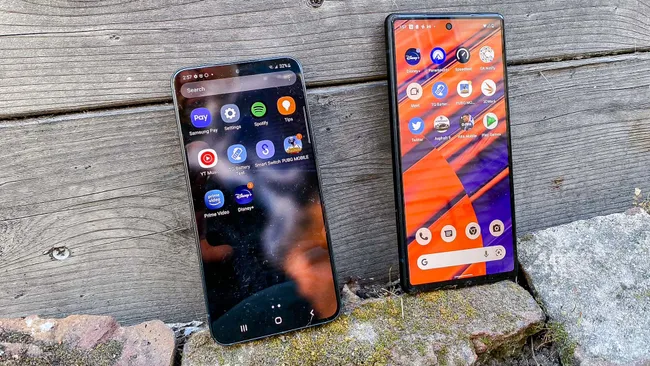In the realm of mobile technology, the terms “Samsung” and “Android” have become intrinsically intertwined, often used interchangeably by those unfamiliar with the nuances of this dynamic ecosystem. However, to truly appreciate the devices we hold in our hands, it is essential to understand the fundamental differences between these two entities and how they collaborate to create the seamless user experiences we’ve come to expect.
At its core, Android is a mobile operating system – a complex software platform that serves as the foundation upon which smartphones and tablets function. Much like how Windows and macOS power desktop computers, Android breathes life into mobile devices, enabling them to run applications, access the internet, and perform a myriad of tasks. It is important to note that Android is not a physical product, but rather the underlying framework that allows hardware manufacturers to build their devices.
Enter Samsung, a global powerhouse in the consumer electronics industry, renowned for its diverse range of products spanning from smartphones and tablets to televisions and home appliances. While Samsung has dabbled in other mobile operating systems throughout its history, its flagship lineup of smartphones and tablets falls under the “Galaxy” brand, and these devices proudly run on the Android operating system.
One of the key differentiators that set Samsung’s Galaxy devices apart from other Android smartphones is the company’s proprietary software layer, known as One UI
One of the key differentiators that set Samsung’s Galaxy devices apart from other Android smartphones is the company’s proprietary software layer, known as One UI (formerly TouchWiz and Samsung Experience). This custom skin, meticulously crafted and applied atop the Android operating system, offers a unique user experience with a wealth of additional features, customization options, and Samsung-developed apps and services that are not inherently part of the core Android experience.
Examples of these enhancements abound, from the intuitive Edge Panels that provide quick access to frequently used apps and tools, to the adaptive Modes and Routines that allow users to automate their device’s settings based on their daily activities. The Secure Folder, a sandboxed environment designed to safeguard sensitive data, is another testament to Samsung’s commitment to delivering a tailored experience for its users. Notably, many of Samsung’s software innovations have served as inspiration for future Android updates, blurring the lines between the company’s contributions and the core Android experience.
It would be a misconception, however, to assume that Samsung is the sole manufacturer leveraging the Android platform for its devices. In fact, other major players in the smartphone market, such as Google, Sony, Motorola, OnePlus, Xiaomi, Oppo, and Vivo, also build their devices on the Android foundation. Each of these companies adds its own unique twist to the Android experience, creating a diverse ecosystem where users can choose from a wide range of offerings, each with its own distinct personality and feature set.
The core, unaltered version of Android developed by Google is referred to as “stock Android.” While devices offering the stock Android experience were once a rarity, they have become more prevalent in recent years, particularly with Google’s own Pixel lineup, which serves as a direct competitor to Samsung’s Galaxy series, offering users an unadulterated Android experience straight from the source.
Just as Android itself evolves with each new major release – transitioning from quirky dessert-themed monikers like Nougat and Oreo to the more pragmatic numerical designations such as Android 13 and Android 14 – Samsung’s One UI also undergoes periodic updates to keep pace with these advancements. Generally, Samsung introduces a new major One UI version to coincide with each significant Android upgrade, while also rolling out minor updates throughout the year to introduce new features, enhancements, and refinements to the user experience.
However, it’s worth noting that the longevity of software support for Samsung devices is not indefinite. Typically, Samsung supports its newer devices with major Android and One UI updates for four years after their release. After this period, the devices will continue to receive critical security patches to address vulnerabilities and maintain a certain level of protection, but these updates will eventually cease altogether. Nevertheless, Samsung has demonstrated a commitment to improving its software support, promising an unprecedented seven years of major Android updates and security patches for its latest Galaxy S24 lineup – a laudable move that sets a new standard for the industry.
One advantage that stock Android devices like Google’s Pixel phones hold over Samsung’s Galaxy lineup is the speed at which they receive software updates
One advantage that stock Android devices like Google’s Pixel phones hold over Samsung’s Galaxy lineup is the speed at which they receive software updates. Since Samsung employs a custom skin atop Android, there is an inherent delay in the rollout of updates compared to devices running the unaltered Android experience directly from Google. Additionally, the pace of update delivery can vary based on factors such as the user’s location and their carrier, introducing further complexities into the equation.
When it comes to determining whether Samsung produces the best Android phones, the decision ultimately lies with the individual user’s preferences and priorities. Samsung’s dominance in the global smartphone market, commanding an impressive 23.69% share second only to Apple, is a testament to the company’s popularity and the appeal of its devices among consumers.
With a diverse range of offerings catering to various budgets and needs – from the premium Galaxy S lineup, boasting top-tier hardware, cutting-edge features, and a sleek, refined user experience, to the more affordable Galaxy A series that strikes a balance between performance and cost-effectiveness – Samsung provides options for a wide spectrum of users.
However, for those who prefer the unadulterated Android experience as envisioned by Google, or for those who are simply not enamored with Samsung’s One UI skin and its accompanying features, alternative manufacturers like Google with its Pixel lineup running stock Android, or even Apple’s iPhone ecosystem with its tightly integrated hardware and software, may be more suitable choices.
The Galaxy S series, which debuted in 2010 with the first model selling an impressive 20 million units, has been a driving force behind Samsung’s success in the smartphone market. Despite facing challenges and setbacks along the way, the company has shown a remarkable ability to adapt, innovate, and push the boundaries of mobile technology. From the introduction of curved displays that seamlessly blend into the device’s frame, to the audacious embrace of foldable form factors that redefine the very concept of a smartphone, Samsung has consistently demonstrated its willingness to take bold risks and rewrite the rules of the game.
In this ever-evolving landscape, where innovation is the currency of success, Samsung’s ability to balance its commitment to the Android ecosystem with its own unique vision and contributions has been a key driver of its success. By understanding the intricate relationship between Samsung and Android, users can navigate the complexities of this dynamic environment with greater clarity, making informed decisions that align with their needs and preferences.
Whether one opts for the pure, unadulterated Android experience, the tailored and feature-rich Samsung One UI, or an entirely different platform altogether, the end goal remains the same: to empower users with technology that enhances their lives and meets their ever-evolving needs.
Ultimately, the symbiotic relationship between Samsung and Android has given rise to a diverse and vibrant ecosystem, where users can choose from a wide array of devices, each offering its own distinct personality and feature set. Whether one opts for the pure, unadulterated Android experience, the tailored and feature-rich Samsung One UI, or an entirely different platform altogether, the end goal remains the same: to empower users with technology that enhances their lives and meets their ever-evolving needs.



